|
With leaves beginning to fall and hunting
seasons upon us, I thought this to be a good time to briefly
expound upon the subject of muzzleloading. I get a lot of
correspondence on the subject, and within the shooting and
hunting sports there seems to be more division amongst
hunters on this subject than any other. While I claim no
particular expertise on the subject of muzzleloading, I am
very familiar with the principles involved, and have been a
muzzleloading hunter for many years. I have also had the
privilege of hearing arguments on the topic from hunters and
from within the firearms industry. This is not going to be
an authoritative thesis on muzzleloading, but as the title
suggests, just a few of my thoughts and experiences on the
matter.
Muzzleloading is one of the more basic forms
of shooting, and has been around for centuries. Ever since
someone figured out that pouring some powder into a tube
that was sealed on one end and placing a heavier object upon
that powder charge and lighting it, the expanding gasses of
that exploding powder would propel that heavier object with
great force from the tube. It must have brought a huge smile
upon the face of that first successful shooter! From that
time forward, shooters have been trying to improve the
system. However, the newest firearms that we have today
still operate upon that same basic principle of expanding
gasses propelling an object from a tube. Projectiles have
changed, powders have changed, and loads are now
self-contained and fed from a magazine into the breech, but
the principle remains unchanged.
The progress of the muzzleloading rifle is
what causes the greatest disagreement among hunters. There
are those who do not want other hunters to hunt if the
otherís choice of armament differs from their own. Almost
all states now have a special muzzleloading only season, and
some hunters get all worked up over the use of weapons that
seem more progressive than their own. Some hunters like to
use a flintlock rifle with a patched round ball cast over an
open fire and patched with nothing but pillow ticking and
greased with bear fat. Using anything but genuine black
powder is an abomination to these fellows, and I understand
their position. It is indeed fulfilling to enjoy the hunt
this way. It is a connection to our past.
Progressing a little further, many hunters,
including myself, like to hunt with a Hawken style
percussion fired rifle, using either patched round balls or
some type of conical lead bullet. I currently have two
different percussion rifles, both fifty-four caliber. One is
a rifle that I built from a kit about thirty years ago. It
started as a forty-five caliber, but I had it bored and
rifled to fifty-four. It is set up to shoot patched round
balls, and does this well. My other percussion gun is a Sile
Hawken Carbine that I have owned for about twenty years, and
is my primary hunting gun for ranges out to about 150 yards
during muzzleloading season.
I should clarify the term
"percussion". For our purposes here, percussion
refers to a muzzleloader that uses a cup-formed percussion
cap that is placed upon a nipple, that when smacked by the
hammer sends the spark through a small passage into the
breech of the weapon, igniting the charge. I clarified this
to differentiate this system from the more progressive
"inline" system. After all, even modern cartridge
rifles use a percussion system to ignite the powder in the
brass case, so technically, most all rifles are percussion
arms, whether they use percussion caps or metallic primers.
Now we come to the muzzleloaders that
comprise the majority of the muzzleloading rifles sold today
for hunting; those being referred to as "inline
muzzleloaders". Inlines take many forms, from those
resembling a break-open single shot shotgun to weapons that
are adaptations of a modern bolt action cartridge rifle,
sans magazine. Most inlines have a removable breech plug to
facilitate easy cleaning, and use shotgun primers as the
source of ignition. Inline muzzleloaders also seem to be the
guns that cause the most division among hunters. However,
the inline system has been around for well over 150 years,
and is simply another progression in the line of firearms
development.
It seems that the flintlock hunter doesnít
want to hunt in the same area as the percussion hunter and
the percussion hunter doesnít want to hunt with the inline
man. Then comes division over the choice of powder and
bullets. I suppose that a hunter could show up with a
matchlock rifle and look down upon the more-modern flintlock
user. An archer doesnít want to hunt in the same state as
a user of any firearm. I suppose that a hunter with a rock
and a stick could look down his nose at everyone. My point
is that every form of firearm is simply a progression over
another system, with no clear place to draw the line. A
manís choice of any legal hunting weapon should be his
own, and there is room for everyone.
As for the choice of powders, most states
allow the use of black powder substitutes, such as Pyrodex,
Triple-Seven, Black Mag, Clean Shot,
and others. Many hunters will use nothing but black powder,
and donít want anything else allowed. Savage really
stirred up a hornetís nest a few years ago with the
introduction of their inline
muzzleloader that uses modern smokeless powder, such as
is used in cartridge firearms. They might as well have
called the Pope a Godless sinner! There are more heated
discussions over this new muzzleloader than with any other
topic regarding muzzleloader hunting. We need to keep in
mind, however, that smokeless powder is just another black
powder substitute. It was invented, as the name implies, to
fire without emitting a cloud of smoke. From a military
standpoint, this is greatly advantageous, as it does not
give away the position of the riflemen or artillery to the
enemy. Smokeless powder also contains more energy per grain
of powder than does black. If Savage had introduced this
rifle with a new powder that was just as powerful, but
emitted smoke and fouling upon firing, there would be less
controversy. The Savage system offers the great
advantage of more power and minimal fouling, and some
shooters will not accept this. Think about it, a
muzzleloader is simply a rifle that uses no self-contained
cartridge. The breech being sealed, no brass case is needed.
Most black powder substitutes are formulated to measure like
black powder, while offering improved burn characteristics.
Smokeless is no different, except that it measures
differently. Its advantages over other black powder
substitutes are those of cleaner burning and more power. To
a man, every critic, except one, of the Savage 10MLII
smokeless muzzleloader has never fired one. Many have never
seen one, but still offer criticism of the rifle based upon
the powder that it uses. I want to emphasize that the Savage
can use black powder and any substitute on the market as
well as any rifle, but due to the fact that it can be used
with smokeless powder, many hunters want it banned from use
during muzzleloading season. Again, these are shooters who
have never even fired the rifle. I like the Savage, and have
purchased one. It offers greater range, flatter trajectory,
more power, and less fouling than any other muzzleloader on
the market. I love mine.
Now for the one and only critic of the
Savage muzzleloader who has extensively used the rifle; that
being Toby Bridges. I have never met Mr. Bridges, but
have corresponded with him. He was for years the preeminent
proponent of the Savage muzzleloader, and I mention him here
only because of recent developments regarding his
relationship with that firearm. Recently, Mr. Bridges
experienced a catastrophic failure with a Savage
muzzleloader using smokeless powder. This concerned me,
because I own and use an identical rifle. Mr. Bridges has
published this incident on the internet, and is now advising
against the use of the Savage, after years of promoting the
rifle.
I want to preface my following thoughts on
this matter by stating that I have no dog in this fight, and
this is just my opinion, after investigating this matter as
best as I could. There are, however, a few facts that
pertain to the relationship of Toby Bridges and Savage Arms.
Mr. Bridges worked for Savage, with the job of testing and
promoting the 10MLII muzzleloader. He has fired more rounds
through Savage muzzleloaders than anyone to my knowledge.
After a few incidents that are none of my business resulted
in Mr. Bridges having a falling out with the inventor of the
rifle and a run-in with the law, Mr. Bridges also was fired
by Savage Arms, for failure to perform his job, and having a
really poor attitude. Shortly thereafter, Mr. Bridges
suddenly had a 10ML blow up while he was supposedly testing
it. The gun was utterly destroyed, but the shooter was not
scratched. He was supposedly shooting a safe load in
the gun; one which in fact I have exceeded many times. Now
Mr. Bridges declares the Savage unsafe. This is, keep in
mind, after he was let go by Savage Arms. I have seen
pictures of the destroyed rifle. There is no way short of a
divine miracle that someone could have been sitting behind
that rifle with his cheek pressed to the stock, and have not
been seriously injured. My opinion, and it is worth what you
paid for it, is that the gun was intentionally blown up.
Now let us move on to more productive
topics, such as propellants and projectiles for
muzzleloaders.
In my Mountain Rifle, I prefer a .530 inch
round ball cast from pure lead and loaded over a charge of
Goex Ffg black. It is a combination that works very
well in that rifle, and I see no need to try another.
In my Sile Carbine, I like the Lee
REAL bullet, lubed and loaded over 130 grains of Pyrodex
equivalent, or Ffg black. The REAL bullet weighs 380
grains cast from pure lead, and really hammers game hard.
This little rifle is fitted with a two-power pistol scope
with a lighted dot reticle, mounted on the barrel. While
not traditional, it is very effective in thick timber and
low light conditions.
This Sile carbine is the subject of an
ongoing experiment. Back about 1990, if my memory serves
me correctly, Ox-Yoke Products came out with a new
muzzleloading lubricant called Wonder Lube 1000,
and was quickly marketed also by Thompson/Center as
Natural Lube 1000. The premise behind this product
was that it contained no petroleum, which made the fouling
much softer. Petroleum, when mixed with black powder
fouling, makes for a hard residue that builds up in the
bore, and must be removed frequently. The claim was that
there was no need to clean between shots, and that the
Natural Lube seasoned the bore, much like seasoning a cast
iron skillet. Cooks know that a well-seasoned piece of
cast iron will not rust, and even burned food rinses out
easily. I had become accustomed to the ritual of daily
cleaning my muzzleloader with soap and hot water, followed
by a generous dousing of a rust preventative lubricant, as
had most muzzleloading hunters. Every day during hunting
season, after a long day of hunting, I would come home,
fire the gun, and spend the better part of an hour
cleaning the thing. I knew that the fur trappers and
mountain men had neither the provision nor desire to daily
empty their weapon and clean it. I also knew that leaving
their rifles unloaded in bear and hostile Indian territory
was not an option. They used their rifles daily, and
animal fat was their only lubricant, yet there is no
historical record of their weapons rusting beyond the
point of being useful. During the first few years of using
the Sile carbine, even after carefully treating it for
storage in the off season, it would need a new nipple
every year, and I would find that the fire channel had to
be cleaned out, no matter how well I had doused the gun
with rust preventative. I decided to give the
Natural Lube a try. Now, after fourteen years of
never cleaning that rifle, it will fire off each season
just like a new gun. Allow me to clarify that: I have not
cleaned that muzzleloader in fourteen years. I use it each
season, leave it loaded all season, but never clean it. I
use the Natural Lube on the REAL bullets, but that is it.
One year I even left it loaded until the following season.
After being loaded for almost a full year, it fired
without a hitch. I do not suggest that anyone go fourteen
years without cleaning any gun. I regularly clean all of
my guns. I will however hunt with the carbine again this
year, but it will not be cleaned. After hundreds of shots
fired through it and fourteen years of field use, it still
fires off perfectly each season. It is still an ongoing
experiment. The Natural Lube 1000 works, and works well.
Moving on to my Savage 10MLII, there are a
couple of different projectiles that I prefer. I really
like the Hornady 250 grain SST bullet, as well as
the Powerbelt 245 grain Aero. Both of these
projectiles are very aerodynamic for a muzzleloader
bullet, and offer flat trajectories and great terminal
performance. I also like the Barnes X bullet, but
have not yet tested it on game. Hornady has introduced a
new sabot that is made to hold propellant pellets onto the
base. Called the Lock-N-Load, it holds either
Pyrodex or Triple-Seven pellets from Hodgdon. The
pellets slide onto the base of the sabot, held by a stem
that can be trimmed to suit the preferred powder charge.
It is a great system, allowing the fastest reload
possible. The Hodgdon pellets are available in both .45
and .50 caliber, in weights of 30 and 50 grains equivalent
to black. Using different combinations of pellets, I
tested loads with charge weights of
50,60,80,90,100,110,120,130, and 150 grains. The
velocities with these Triple-Seven pellets was linear and
predictable as charge weights increased, from a low of
1196 feet-per-second with one fifty-grain pellet to almost
2000 fps with three fifty-grain pellets attached to the
Lock-N-Load sabot, using the 250 grain SST bullet. The
Lock-N-Load can also be used with any powder by trimming
off the stem, and it loads much easier than Hornadyís
black sabot in my Savage. The Powerbelt bullet uses no
sabot, but has a skirt attached to the base to provide a
primary seal. Upon firing, the lead bullet bumps up to
seal the bore and grip the rifling. With 44 grains of
Hodgdon LilíGun powder, the 245 grain Powerbelt leaves
the muzzle at almost 2300 fps, with good consistency and
accuracy. It is also very easy to load. LilíGun is my
powder of choice in the Savage. It is not listed in
Savageís data with the 10MLII, but offers fine
performance.
Well, there you have it; my thoughts on
muzzleloading today. Even after about 500 years,
muzzleloading shows no signs of becoming obsolete. In
fact, it is still a growing sport.
For more information on the products
mentioned above, look to their respective websites:
  
Got something to say about this article? Want to agree (or
disagree) with it? Click the following link to go to the GUNBlast Feedback Page.
All content © 2004
GunBlast.com.
All rights reserved. |
|
Click pictures for a larger version.
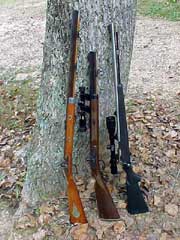
Author's favorite muzzleloading rifles (left-right): .54
caliber Mountain Rifle that Jeff built from a kit some 30-odd
years ago; Sile .54 caliber Hawken carbine; Savage 10MLII
smokeless muzzleloader. These rifles represent a good
cross-section of muzzleloading rifles seen today, from a
"traditional" percussion-cap rifle to a more modern
version with scope, and to the most modern muzzleloader
available today. These rifles also represent the author's view
that muzzleloading rifles are both links to our past and
practical hunting tools, and that all have their place in the
muzzleloading world.
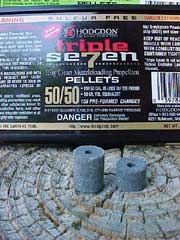

Some of the most welcome advances (at least to the
author) in muzzleloading technology are the modern powders
available to today's muzzleloaders. Modern powders are
cleaner-burning, more stable, and quicker and easier to store,
measure and use. Shown are Hodgdon's 777 pellets in 50-grain
and 30-grain pre-measured charges.
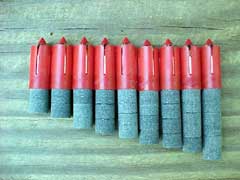
Various charges of 777 pellets on Hornady's Lock-N-Load
sabots with 250 grain SST bullets (left-right):
50,60,80,90,100,110,120,130,150 grain charges. Such
innovations make muzzleloading quicker, easier and safer.
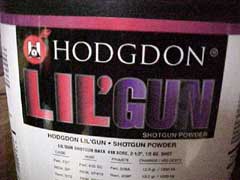
Another breakthrough in muzzleloading technology was
Savage's introduction of muzzleloading rifles with the ability
to use modern smokeless powders. Jeff particularly likes
Hodgdon's Lil'Gun powder in the Savage gun.

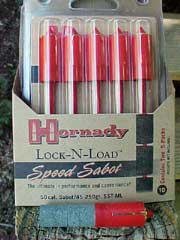
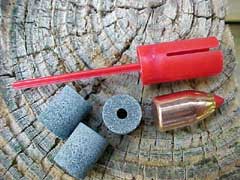
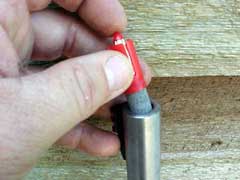
Hornady's SST bullets and "Lock-n-Load" sabots
are great innovations for the modern muzzleloading hunter.
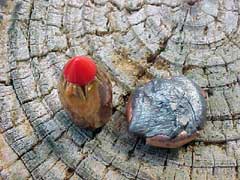
The performance of Hornady's SST bullets can be seen in
this example, recovered from
the carcass of a large Russian boar. The bullet performed
perfectly, showing textbook expansion and maximum weight
retention, and dropped the boar in his tracks. An unfired
bullet is shown on the left for comparison.
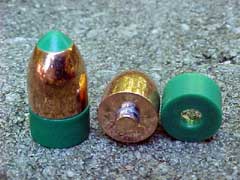
Powerbelt's Aero bullets are hard-hitting, fast and
accurate. The plastic skirt attached to the base provides a
very effective seal without a sabot.
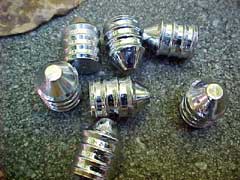
Lee's REAL bullets have long been among Jeff's
favorites.
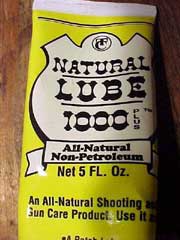
Even bullet lubrication technology has improved to help
make the muzzleloading hunter's life easier, as exemplified by
Thompson-Center's Natural Lube 1000.
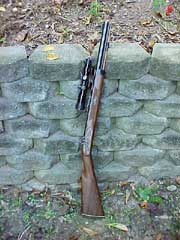
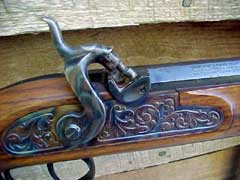
Author's Sile .54 is the subject of an experiment by the
author demonstrating that conventional wisdom is not always
law. Through fourteen years of seasonal use with no cleaning,
this rifle remains as reliable and accurate as ever.
|
![]()